Which Music Streaming Service Has The Best Audio Quality
Best music streaming services 2021: free streams to hi-res audio
Best music streaming services Buying Guide: Welcome to What Hi-Fi?'s round-up of the best music streaming services you can subscribe to in 2021.
Online platforms have altered the landscape of the recording industry so much that even audiophiles with a deep love for physical formats have to admit that it's hard to completely resist the lure of music streaming services when it comes to getting your music fix. Access to tens of millions of tracks at the tap of a touchscreen means it has never been easier to hunt down old favourites or discover brand new bands and artists.
There's a wide range of streaming services to choose from, with those such as Amazon, Apple, Spotify and our 2021 Award-winning service Tidal offering unlimited access to huge catalogues of music, which can be streamed over the internet or a mobile network or downloaded directly to your device for offline listening.
So how much can you expect to pay? Some services offer limited free music apps (supported by adverts with limited playback options) or free trials of up to three months, but in the main, you pay a set monthly subscription fee.
The quality of these streams varies between services. Those concerned less by the outright quality and more with getting bang for your buck can listen to compressed streams at 320kbps from the likes of Spotify.
But you don't have to sacrifice quality. Tidal, Deezer and Qobuz all have subscription tiers that allow you to access CD-quality streams and, where the content is available, even hi-res music.
In the past, this increase in quality has typically come with an increase in subscription cost, but Apple recently went rogue and added lossless and hi-res tracks to Apple Music without charging extra, sending a ripple through the industry. Amazon has already responded by dropping the extra charge it had previously levied for its hi-res and lossless content, and one has to wonder if rivals will follow suit.
In other words, these are turbulent times for music streaming services, but they're also exciting times for those of us who are streaming the music as competition is greater than ever before. So which is the best music streaming service for you? Read on to find out.
- Best Black Friday hi-fi and audio deals – great prices on great gear
- Hi-res music streaming services compared: which should you sign up for?
- 12 of the best-produced recordings to test your speakers
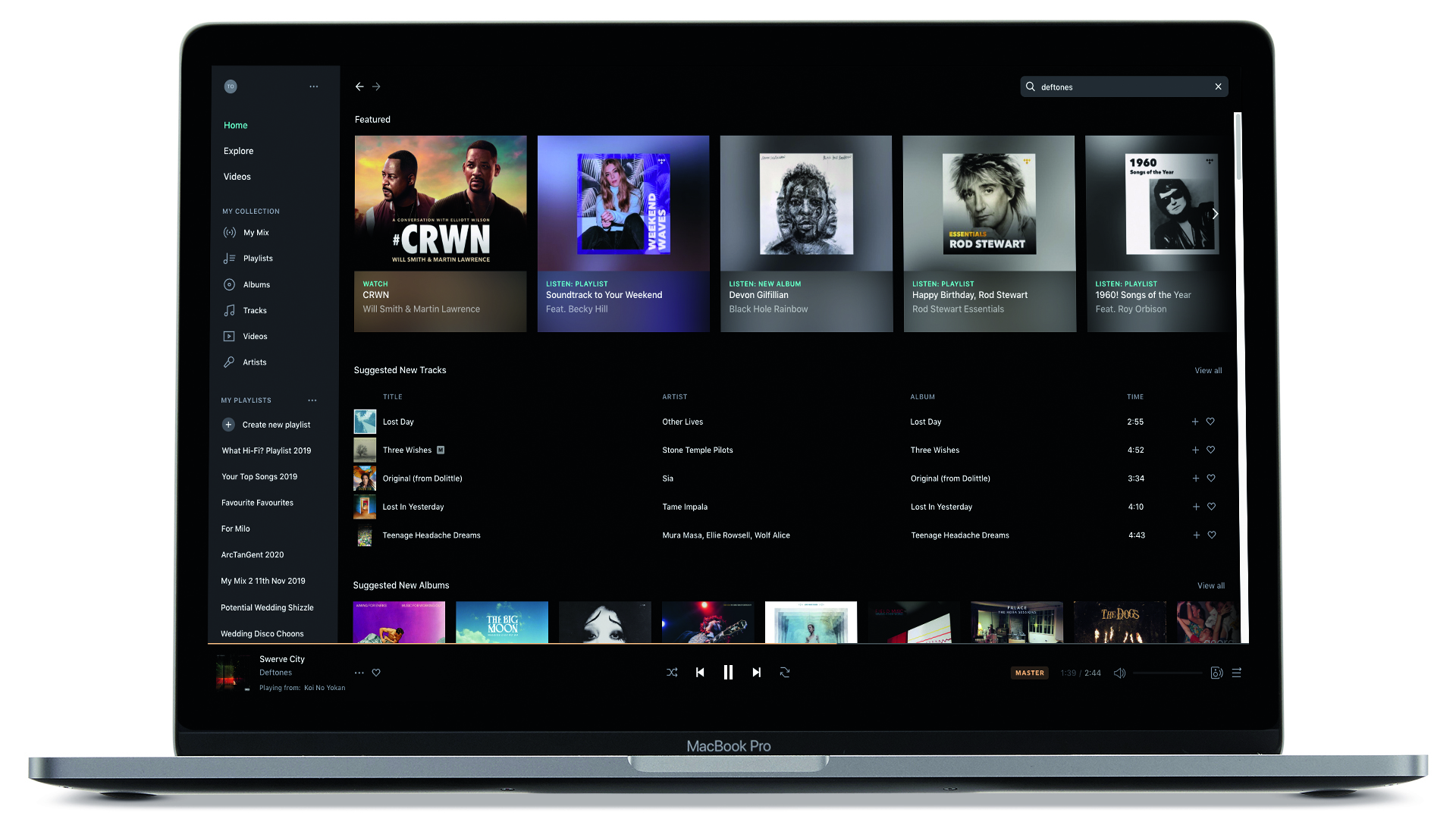
1. Tidal
High quality audio with wide range of content.
Specifications
Cost: £9.99/mth or £19.99/mth (HiFi tier)
Quality: 320kbps, CD-quality streaming, 24-bit/96kHz
Files: FLAC, AAC
Library size: 60 million+, millions of hi-res audio
Platforms: iOS and Android apps, desktop app, web player
Reasons to buy
+Great sound quality +Hi-res Masters tracks +Intuitive interface
Reasons to avoid
-Hi-res tier undercut by Amazon
Tidal has long been at the forefront of high-quality streaming, but the service has recently made several changes to its pricing structure that sees it becoming more accessible with the inclusion of lossless 16-bit 44.1kHz audio streams in its standard plan.
For £9.99 / $9.99 / AU$11.99 per month, subscribers to the newly rebranded 'Tidal HiFi' plan get interruption-free access to audio at up to 1411 kbps (compared to 320kbps previously). However, there are still some perks that are reserved for Tidal's top tier.
Besides CD-quality streams, 'Tidal HiFi Plus' affords its subscribers access to millions of hi-res audio tracks that are typically 24-bit/96kHz but do go up to 24-bit/192kHz. Called 'Tidal Masters', these music files are encoded using MQA (Master Quality Authenticated) technology, which the company says allows for more efficient packing of the hi-res data. HiFi Plus costs £19.99 / $19.99 / AU$23.99 per month and also includes tracks mixed in immersive sound formats (Dolby Atmos Music and Sony 360 Audio recordings).
But hi-res and CD-quality streams aren't the be-all and end-all of Tidal's offering. Customers in the US can take advantage of the service's first-ever free plan, called 'Tidal Free', which offers the company's complete library of 80 million tracks at 160kbps with "limited interruptions" from Tidal that will "aim to educate consumers on the music industry."
You can access Tidal through iOS, Android, desktop – all of which offer hi-res streams – as well as a browser-based player and a good spread of other platforms, such as Sonos. Tidal Connect also now allows you to connect via wi-fi to a growing list of products.
It may have the priciest premium account tier on our list, but Tidal's ease of use is exemplary, and sound quality is exceptional across the board. The CD-quality streams display excellent levels of detail and expression, and hi-res recordings take this up a level. Sonically Tidal still has the edge over almost all the competition, although Apple Music's ALAC streams manage to match it for openness and subtlety.
Tidal is also now distinguishing itself from the rest of the pack by introducing initiatives designed to provide artists with direct payments (from HiFi Plus subscribers only) that represent each user's listening habits rather than being attributed by aggregation.
If you're a conscientious music fan looking for the best high-quality streaming experience, with an extensive catalogue, immersive content, broad device support, improved discovery features (and you aren't already tied into the Apple ecosystem), Tidal is unquestionably it.
Read the full review: Tidal
- Tidal Masters (with MQA) review
- Our pick of the best Tidal Masters albums
- 25 Tidal tips, tricks and features

2. Spotify
Easy to use and to discover new music.
Specifications
Cost: £9.99/mth, £4.99 (student tier), £14.99 (family tier)
Quality: 320kbps
Files: MP3, M4P, MP4
Library size: 60 million+
Platforms: iOS and Android apps, desktop app, web player, smart TV apps, connected speaker support, cars
Reasons to buy
+Exhaustive discovery features +Intuitive interface +Free tier
Reasons to avoid
-Others sound better -No lossless or hi-res (yet)
Spotify remains comfortably the most popular and accessible way to get your music fix. Not only does it offer decent 320Kbps quality, but there is a huge library of over 40 million songs. These can be played on pretty much any device you own, thanks to intuitive iOS and Android apps and support in numerous smart TVs, connected speakers and other AV kit courtesy of Spotify Connect.
The service is renowned for its new music discovery algorithms, which compile excellent weekly playlists tailored to your music tastes. And the more you listen, the more the playlists evolve – a compelling reason to choose Spotify as your streaming service.
If your limit is £10 per month, Spotify delivers a comprehensive and complete experience and even offers a 40 per cent discount for students. Plus, if you don't have any spare cash to spend, there's a free tier that offers lower-quality streams supported by adverts.
Oh, and a HiFi tier is coming! Although we still don't know how much it'll cost (or official launch date), we do know it will give subscribers the chance to listen to "music in lossless audio format, with CD quality".
As noted above, the best option within Spotify's streaming quality settings right now is 'Very High', which delivers audio tracks with a bitrate of 320kbps. By comparison, a CD contains a 1411kbps bitrate. So, 'CD-quality' of around 1411kbps should be a solid step up from what Spotify users are used to. A higher bitrate means more information, which should translate to a better sound (that's the simplified version). Essentially, we're excited to see what Spotify has got in the pipeline.
Read the full review: Spotify
- 33 Spotify tips, tricks and features
- 30 of the best podcasts on Spotify
- 11 of the best Spotify playlists to listen to right now

3. Apple Music
An appealing streaming service with intelligent curation, a vast catalogue and good sound quality.
Specifications
Cost: £9.99/mth, £14.99/mth (family tier) £99 (12mths)
Quality: Apple Music Lossless (24-bit/48kHz) and Hi-Res Lossless (up to 24-bit/192kHz)
Files: AAC
Library size: 75-million+ in CD resolution or higher
Platforms: iOS, desktop app
Reasons to buy
+Well-curated playlists +Hi-res sound quality for little money +Excellent catalogue
Reasons to avoid
-Plenty of rival options
Unsurprisingly, Apple Music is aimed squarely at Apple users, so Android owners often want to look elsewhere – although that's slowly changing. However, if you're fully immersed in Apple's ecosystem, Apple Music makes a lot of sense. It costs a competitive £10 per month, or you can pay an annual fee of £99. There's a £5 per month student deal, while a family membership covering up to six people costs £15 per month.
In a recent announcement, Apple has said that it will also launch a new subscription tier before the end of 2021 that only works via voice control that will cost £4.99 / $4.99 / AU$5.99. Crucially 'Apple Music Voice Plan won't let you use the Apple Music app to play songs and doesn't offer access to Apple Music's premium offerings, including Spatial Audio, Lossless Audio, Lyrics and music videos. You'll need to switch to the Individual or Family plans if you fancy any of those features.
Whether using the desktop or mobile app, the interface is easy to navigate with a simple yet effective layout. The service does a great job of curating playlists and serving up useful and intelligent recommendations. While there's no free tier, Apple has now added support for lossless audio and spatial audio with Dolby Atmos, crucially, without charging extra. The service's 75 million-strong catalogue is available in CD-quality (16-bit/44.1kHz) with 20 million songs available in hi-res (24-bit/48-192kHz) at launch, increasing to the entire library by the end of the year.
However, there are some limitations on what kit can playback Apple's new high-quality offering. For example, although Apple Music with Dolby Atmos will work with all headphones and Apple's own HomePod and HomePod Mini will support Lossless at some point (following a software update), Apple's own headphones don't support lossless audio.
Also, while Apple's iPhones (since the iPhone 7) natively support lossless, that only applies to Apple Music Lossless and not the highest quality Hi-Res Lossless. So if you want to listen to Apple Music tracks above 24-bit/48kHz on your iPhone, you'll need to shell out for an external DAC and use a wired pair of headphones.
Apple hasn't revealed the bitrate it uses for its standard streams, but tracks still sound clean, snappy and entertaining. Compared with similar tracks on Spotify (320kbps streams), Apple's have greater subtlety and more space around instruments while its ALAC (Apple Lossless Audio Codec) streams match Tidal for openness and subtlety even sometimes sounding just a touch clearer.
If you're an Apple user, this service is undoubtedly the most attractive and best-value hi-res streaming service out there.
Read the full review: Apple Music
- 30 Apple Music tips, tricks and features
- There's a problem with Apple Music Lossless (and we're excited to see the solution)
- 10 Apple Music playlists to listen to right now
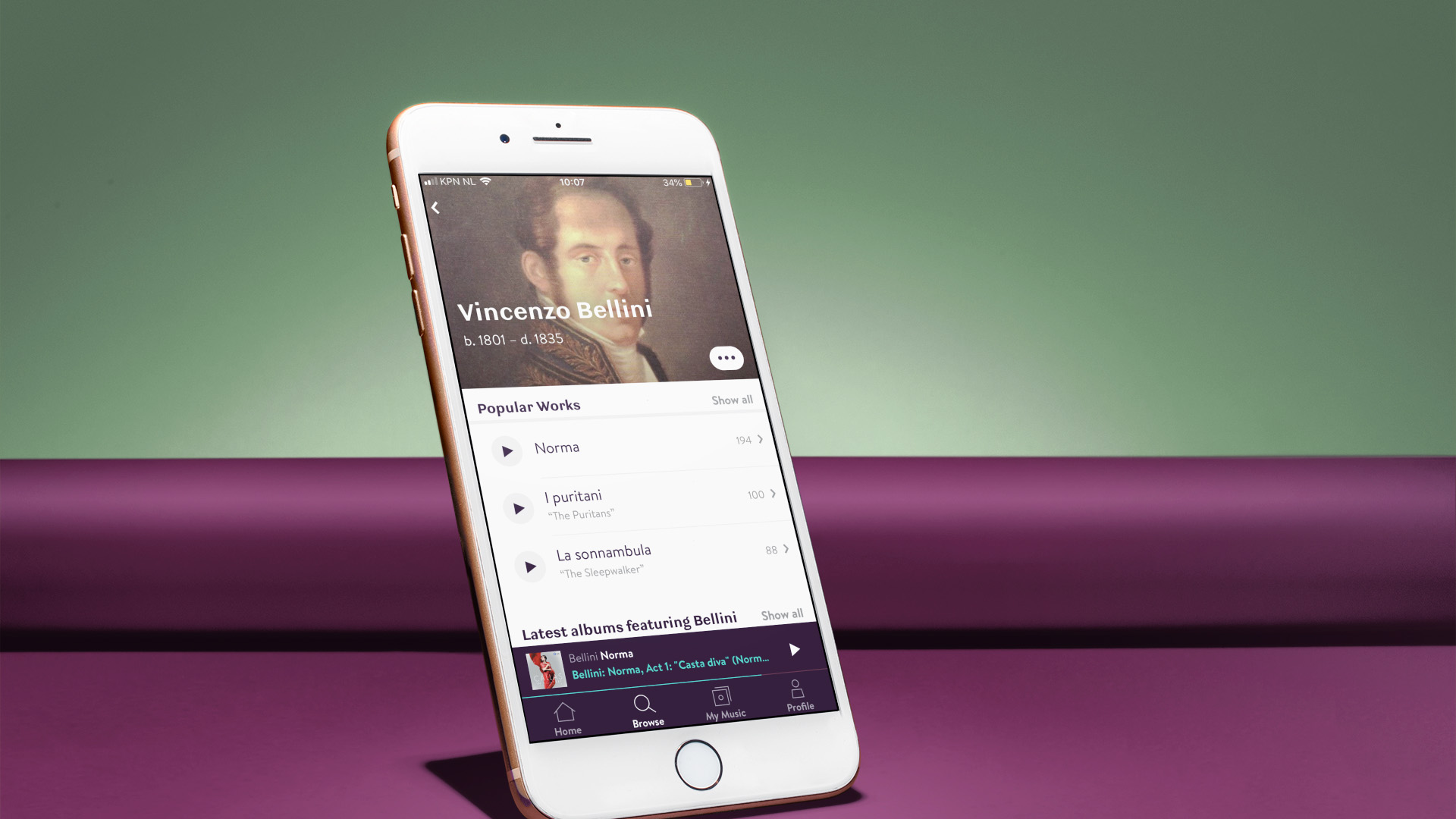
4. Primephonic
The go-to app for anyone interested in classical music
Specifications
Cost: £8/mth, £80/yr (MP3-quality) / £15/mth, £150/yr (hi-res audio)
Quality: 320kbps, 24-bit
Files: MP3, FLAC
Library size: 1 million+
Platforms: iOS and Android apps, web player
Reasons to buy
+Revamped interface +Lots of playlists +Help for not classical-savvy +Great sound
Reasons to avoid
-Catalogue still not exhaustive
If you're a classical music fan, you'll get a kick out of Primephonic. Since launching in 2017, the service has been revamped and now claims to offer over 3.5million classical music tracks – including a good few you won't find elsewhere. What's more, Primephonic is welcoming not only to those who know what they're looking for but to those who are looking to explore the genre from a standing start.
The platform includes Maestro, an in-app listening guide offering detailed, step-by-step "walkthroughs" of classic works. With Maestro, you can listen to classical music alongside a written description of the musical passage and the instruments, as and when they are heard.
The £10 per month (or £100 per year) tier provides access to 320kbps MP3 streams, but you can splash out £15 per month (or £150 per year) for glorious 24-bit FLAC streams. The latter, the 'Platinum' tier, is cheaper than some rival 24-bit offerings, though of course, the focus is much narrower. While there is no free tier a 14 day free trial is available.
There are still a few gaps in the library around contemporary classical artists and we'd appreciate a desktop app, but thanks to a much-improved interface, the addition of offline playback and excellent all-round sound quality, we have no problem recommending Primephonic.
Read the full review: Primephonic
- Check out 8 of the best classical music tracks for testing speakers
- How Primephonic is stepping in to fill a void created by Spotify
- 30 of the best piano tracks to test your system
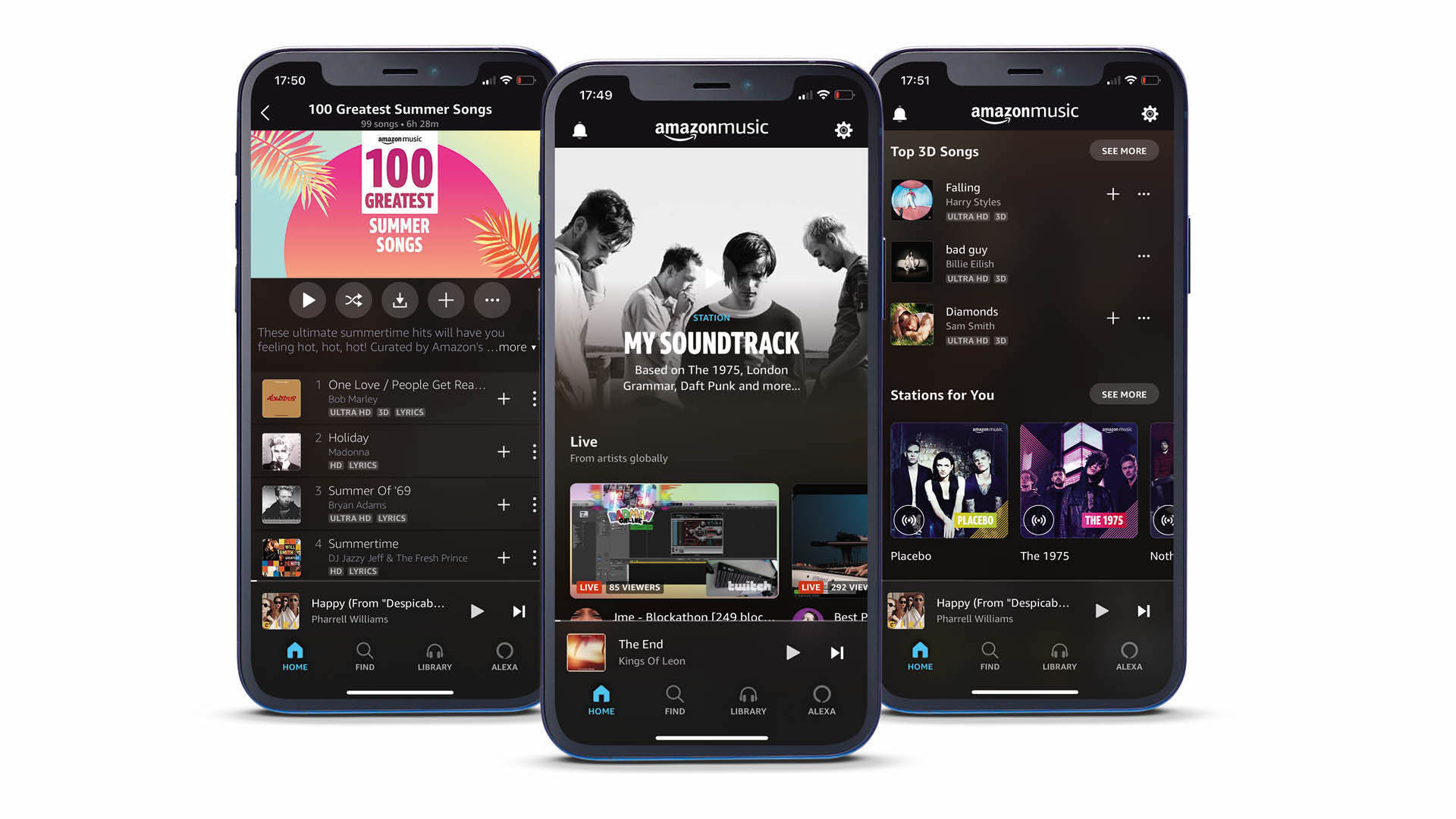
5. Amazon Music Unlimited
A Spotify rival, particularly attractive for those in Amazon's fold.
Specifications
Cost: £9.99/mth, £15/mth (family tier), £14.99/mth (Music HD)
Quality: 3730 Kbps (HD)
Files: N/A
Library size: 70 million+
Platforms: iOS and Android apps, desktop app, web player, connected speaker support, cars
Reasons to buy
+Discount for Prime subscribers +Excellent catalogue +HD and Ultra HD content is included… +and sounds good
Reasons to avoid
-No free tier -Music discovery could be better -Mobile app can be buggy -User experience lacks a little cohesion
At £9.99 per month, Amazon Music Unlimited's pricing is competitive with our top picks for streaming services. And if you subscribe to Amazon Prime, this drops to just £8, undercutting the rest of the field. What's more, Amazon is now including its Amazon Music HD library as part of Amazon Music Unlimited at no extra cost. Featuring 70 million tracks with a CD-quality bitrate of 16 bit/44.1kHz plus millions more in 24bit and up to 192kHz, we gave it five stars under intense review back when it incurred an extra £5 charge.
Music Unlimited is compatible with smartphones and tablets via its Android and iOS apps and PCs and Macs via its web player or desktop app. Fire tablets and TVs are also compatible while some in-car systems and audio products (including Amazon Echo and Sonos speakers) also support the service.
The mobile app looks good on smartphones and tablets, but isn't quite as intuitive and reliable as those provided by Apple or Spotify. Those rival services also have the edge when it comes to music discovery and curated recommendations although Amazon does provide plenty of suggestive guidance, allowing you to browse the catalogue with minimal fuss and find new music.
Amazon has been coy about revealing its streaming bitrate for its standard tier, claiming to support "multiple bitrates", but it sounds not dissimilar from Spotify's 320kbps streams. Listen to the two side-by-side and differences are barely audible: Amazon is a touch better in terms of dynamic subtlety, and there's a pleasantness to its rounder-sounding presentation.
While it may be evasive about its standard tier, Amazon Music has gone all-in on high-res and 3D formats and is not at all bashful about it. The number of Ultra HD songs on the platform has tripled since the format was introduced in 2019 and unlimited subscription-holders also have access to a rapidly growing catalogue of songs mixed in Dolby Atmos and Sony's 360 Reality Audio, an offering that (according to Amazon) has grown by more than 20 times since spatial audio was originally introduced to its listeners.
Notably, Amazon Music Unlimited listeners can now stream music mixed in spatial audio on iOS and Android devices with their existing headphones – no special equipment required – as well as on select devices that support Alexa Cast.
For Prime subscribers looking to take advantage of the reduced subscription cost and the added CD-quality and hi-res tiers provided by Amazon Music HD, Music Unlimited makes a lot of sense and is certainly a tempting alternative to more premium services.
Read the full review: Amazon Music Unlimited
- Amazon Music Unlimited vs Spotify: which is better?
- With Apple and Amazon offering lossless streaming for no extra charge, what now for their rivals?
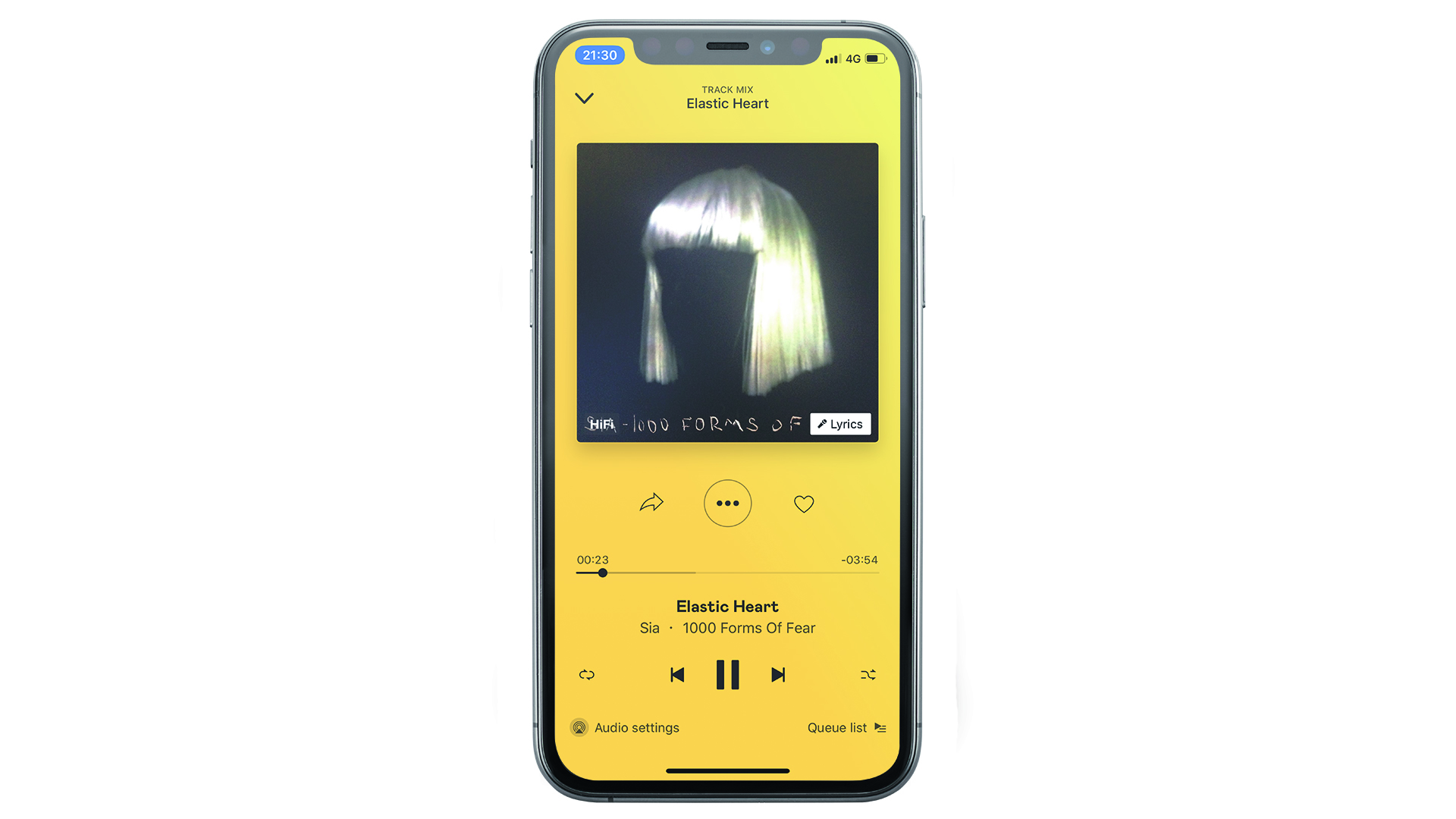
6. Deezer
A comprehensive and well-connected service
Specifications
Cost: Free, £10/mth, £15/mth(CD-quality) £20/mth (Family tier)
Quality: 128kbps, 320kbps, 16-bit
Files: MP3, FLAC
Library size: 56 million+
Platforms: iOS and Android apps, desktop Windows and Mac apps, Sonos, Yamaha MusicCast, Bang & Olufsen speakers, MOON by Simaudio network audio system
Reasons to buy
+Vast catalogue and device support +CD-quality HiFi tier +Envelope-pushing 3D audio
Reasons to avoid
-No hi-res streaming -Spotify does discovery better -Tidal does hi-fi better
Back in 2017, Deezer became the first music streaming service to celebrate its 10th birthday. As with any significant coming of age, the French company celebrated by making 2017 a year of big change. It rebranded its CD-quality tier, giving it a new name and price, and making it accessible on more apps and platforms.
Fast forward to 2021, and while Deezer has teamed up with hi-res streaming partner, MQA, there's no sign of hi-res audio streams on Deezer as yet – only 16-bit CD quality. That puts it at a disadvantage compared to the hi-res music you'll find on Tidal and Qobuz. Meanwhile its core, non-HiFi subscription, falls just a whisker short of Spotify when it comes to ubiquity, discovery and presentation.
Deezer does have one up ace up its sleeve: 360 Reality Audio tracks. The immersive format is a bit like Dolby Atmos, but specifically for streamed music. It's a nice bonus but it's only available to subscribers of Deezer's £14.99 ($14.99, AU$14.99) a month 'HiFi' tier, and only through a separate iOS/Android app. Also while Deezer was the first music streaming service to offer 360 Reality Audio, it has since been joined by others including Tidal and Amazon Music HD making it no longer a unique offering.
Thankfully, Deezer's extensive catalogue, vast device support, user-friendly interface and decent non-music content lays the foundations for a service that can still rival the best. And there's a free tier if you want to try it first.
Read the full review: Deezer
- Hands on: 360 by Deezer review
- 10 of the best tracks to test your headphones
- Sony 360 Reality Audio: everything you need to know
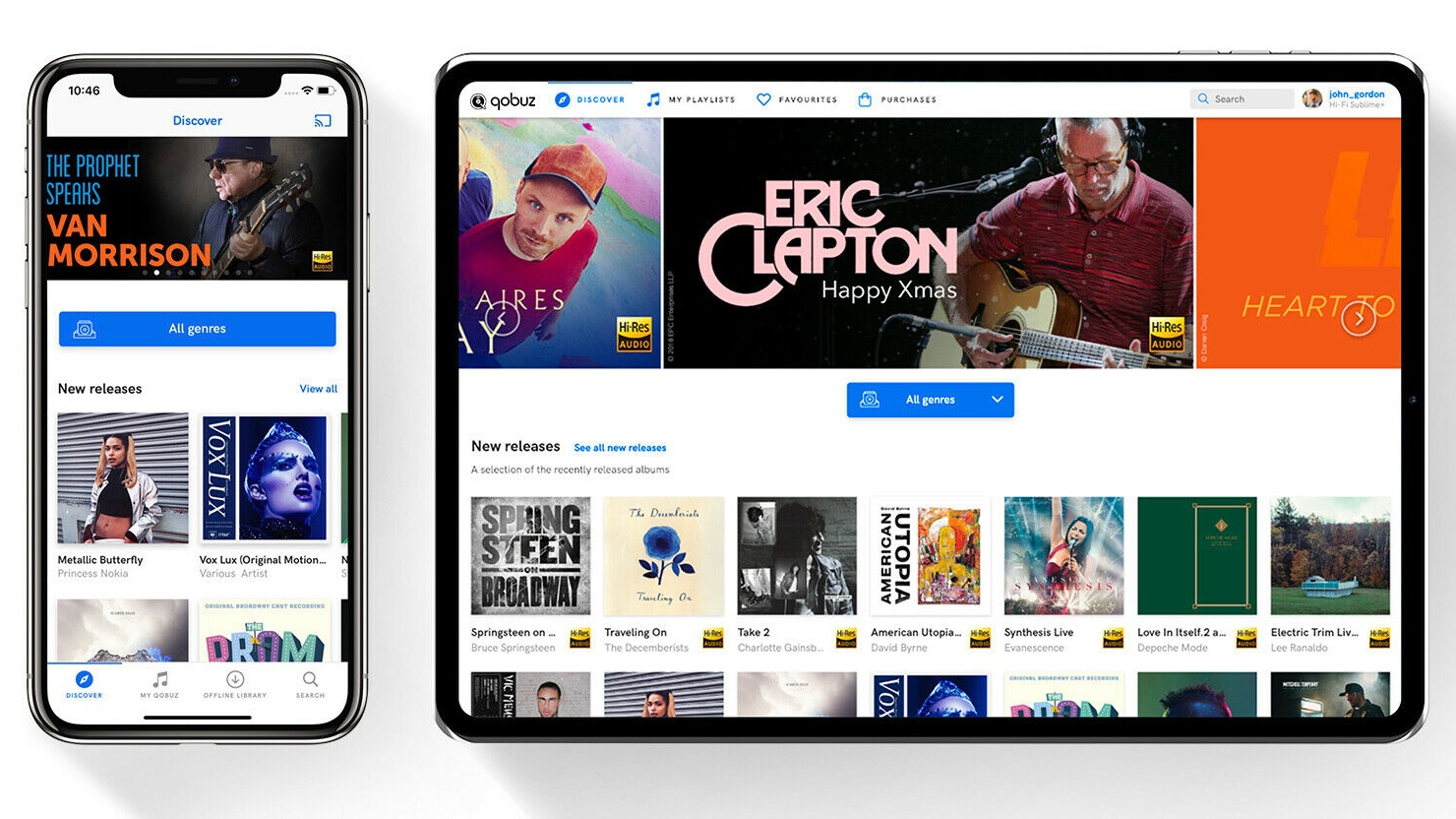
7. Qobuz
The most advanced streaming ecosystem out there, but not necessarily the best value.
Specifications
Cost: £14.99/mth or £149.99/yr, £249.99/yr, £24.99/mth (Family tier)
Quality: 16-bit/44.1kHz, up to 24-Bit/192kHz
Files: FLAC
Library size: 70 million+
Platforms: iOS, Android, desktop app, web player
Reasons to buy
+Large hi-res library +Excellent CD-quality streams +Eclectic catalogue +Hi-res on mobile app
Reasons to avoid
-Tidal's hi-res streams sound better -Library doesn't match some competitors
Qobuz might not be the most well-known streaming service, but it is arguably the most advanced in terms of file quality. Its Sublime+ tier gives users the ability to stream over 70,000 24-bit hi-res albums and download tracks at discounted prices, but you need to spend £250 on an annual subscription. Below this tier sits a hi-res Studio tier £15 per month or £150 per year.
Qobuz is available on lots of devices. There's a web player, desktop and mobile apps, plus several networked streaming products that are also compatible with the service. While its 'Carplay Online' feature allows users to view and launch their favourite playlists and tracks directly from the integrated screen of their car. Overall, Qobuz's interface is nice to use across desktop and mobile, although the curation could be better.
The service recently introduced 'My Weekly Q'. This AI-powered recommendation engine serves up a personalised playlist of musical discoveries it thinks you'll enjoy, based on the listening habits of other users with similar tastes to yours.
When it comes to the catalogue, Qobuz isn't quite as pop-heavy as its closest rivals and has some pretty major blind spots in its catalogue, but there's still a decent balance, and it's worth the free trial to see if most of what you want is on there.
The only other issue is that, while Qobuz claims to have more hi-res tracks than rivals, Tidal's hi-res streams also sound marginally better for timing and dynamics.
Qobuz is, however, the first music service to bring 24-bit hi-res audio streaming to Sonos speakers, making it a good choice if you've invested in the Sonos ecosystem.
Read the full review: Qobuz
- Qobuz talks Amazon Music HD, 3D audio, new features and more
- Where can you buy hi-res music? Here are the top download sites
- How to play hi-res music on your iPhone
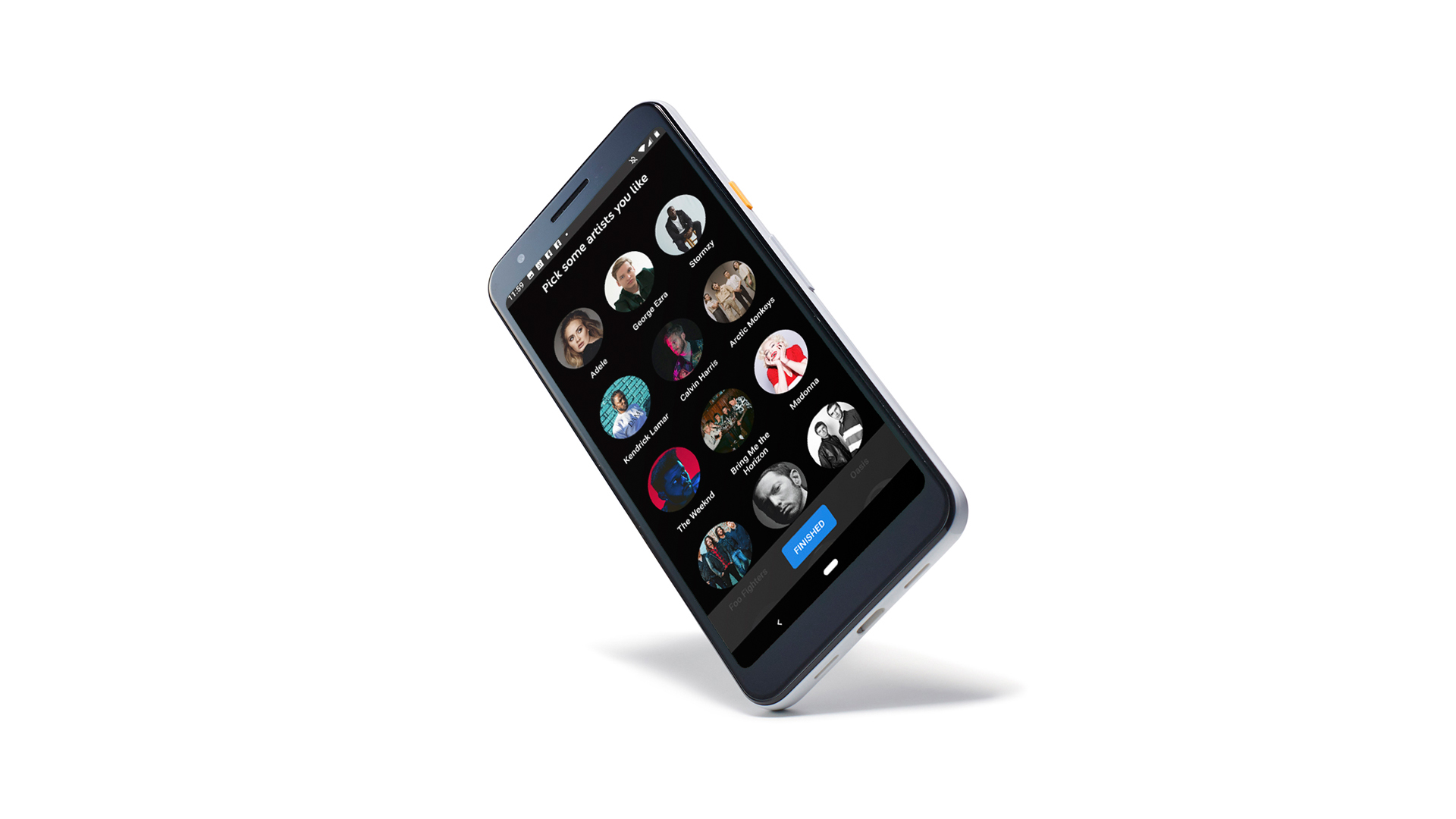
8. YouTube Music
A music service for fans of music video
Specifications
Cost: Free, £10/mth, £15/mth (family)
Quality: 256kbps
Library size: 40 million+
Files: AAC
Platforms: iOS and Android apps
Reasons to buy
+Brilliant search feature +Adds YouTube's music videos +Lots of live recordings
Reasons to avoid
-Underwhelming music discovery -Audio lacks real detail -Streams too compressed -Catalogue needs improving
The service rather underwhelmed us at launch, but YouTube Music is now starting to look like it's ready for the challenge. The user interface is solid, and the search function is terrific, turning up long-lost musical gems through its video vaults. The problem is that the competition's quality remains an issue: Spotify and Apple Music are the mass market titans to tackle, and both already offer five-star services.
There are a few good reasons to choose YouTube Music, though. The free tier is easy to use and supported by ads but, for £10 per month, you can sign up to YouTube Music Premium, which is ad-free and allows downloads for offline listening too. (Students can get it for just £5).
The app is available through Sonos speakers and anything Google Assistant-powered, such as Google Home devices or third-party devices such as the Sony LF-S50G and JBL Link 20. As for sound quality, the 256 kbps streams are far from unlistenable but sound compressed in a way that main rivals don't.
Still, if you like the USP here – music videos, rather than audio – and the ability to seek out a recording played live at a certain venue on a certain date, YouTube Music has plenty to offer.
Read the full review: YouTube Music
- Best music streamers 2021: upgrade to a wireless system
- High-resolution audio: everything you know
- How to make your computer sound better
Mary is a staff writer at What Hi-Fi? and has over a decade of experience working as a sound engineer mixing live events, music and theatre.
Which Music Streaming Service Has The Best Audio Quality
Source: https://www.whathifi.com/best-buys/streaming/best-music-streaming-services
Posted by: adamssposee1993.blogspot.com

0 Response to "Which Music Streaming Service Has The Best Audio Quality"
Post a Comment